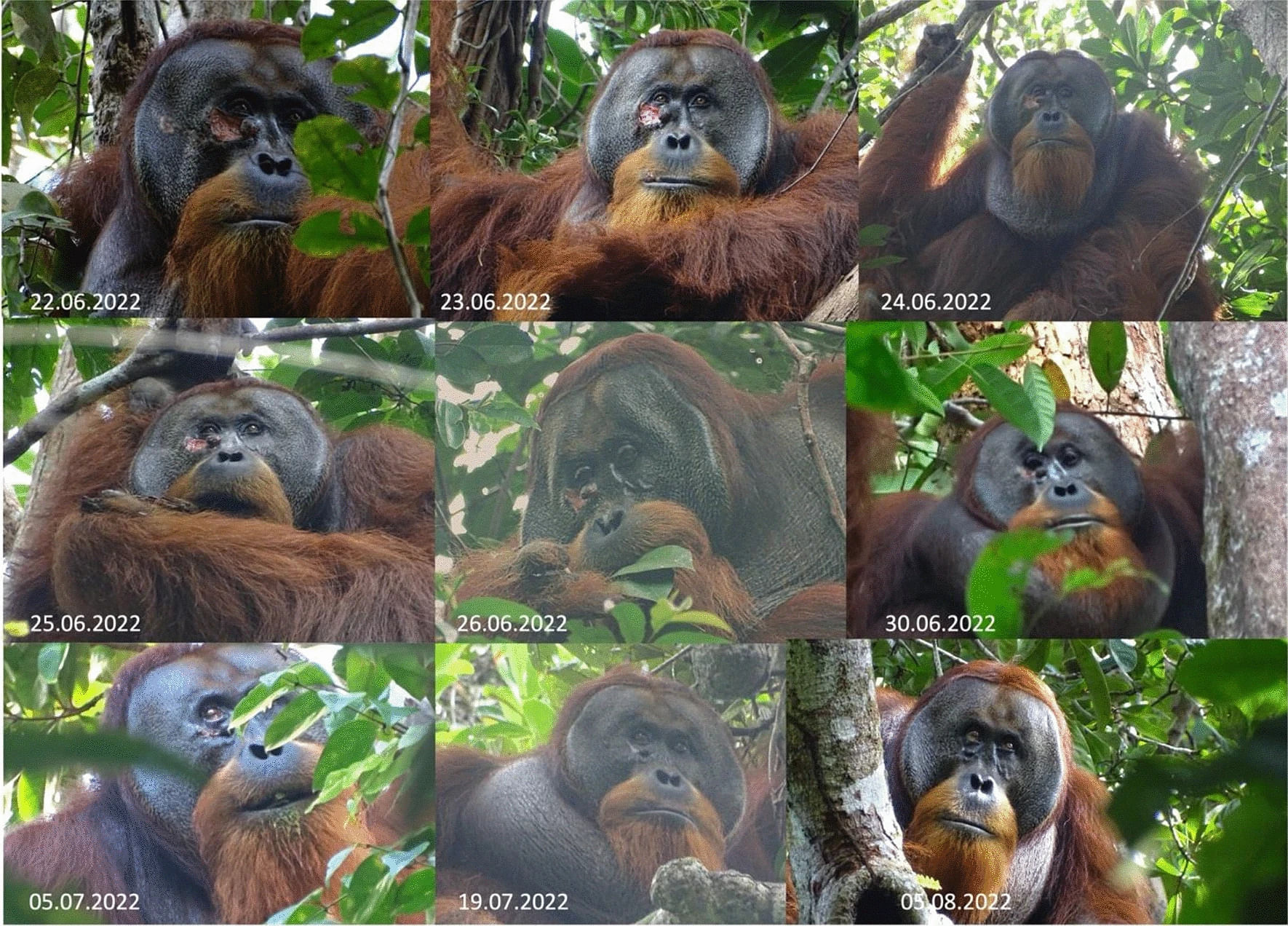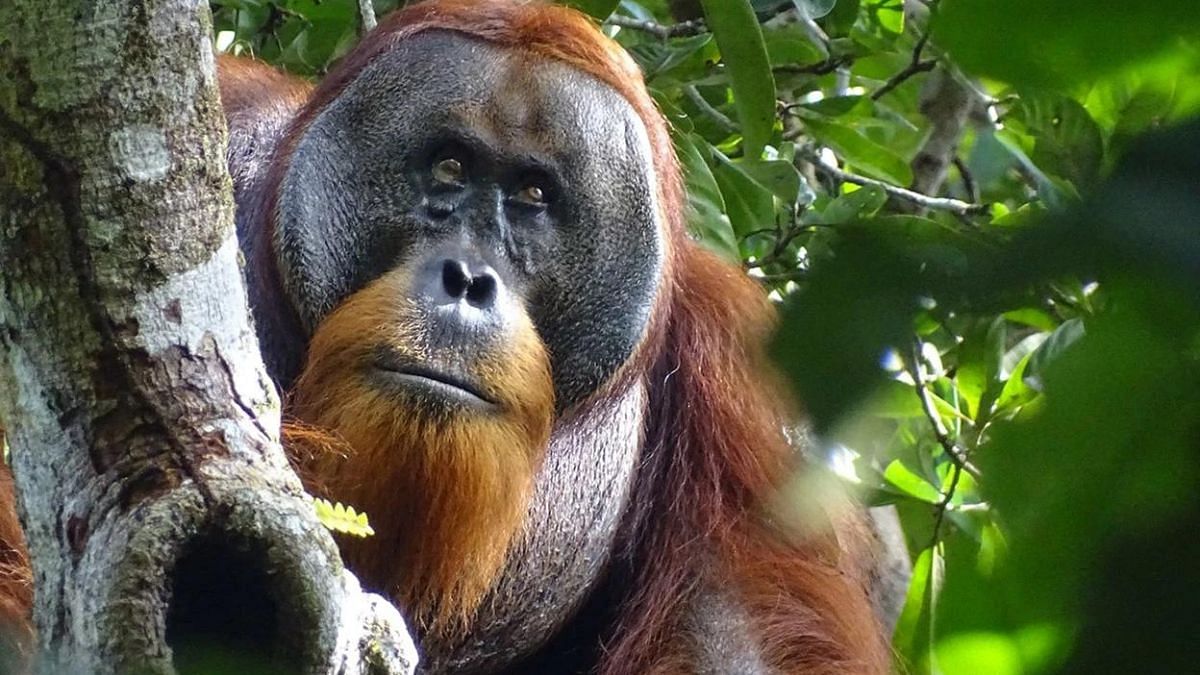Bengaluru: For the first time, an animal has been documented medicating itself with a biologically active plant to cure an open wound.
An adult male Sumatran orangutan named Rakus, in the Suaq Balimbing research area in Indonesia, was observed to have used a medicinal plant to treat an injury on his face.
Researchers saw Rakus pluck and chew leaves of Akar Kuning, or Fibraurea tinctoria, a plant commonly used in the region by local inhabitants for its medicinal value as an analgesic, antipyretic and diuretic to treat dysentery and malaria.
The observations, made over a month beginning 22 June 2022 by German and Indonesian researchers, were published as a study in Nature’s Scientific Reports journal this week.
It was noticed that the ape selectively ripped off the leaves three days after sustaining an injury on his cheek, likely during a fight with other orangutans. He did not swallow the leaves after chewing them but used his fingers to apply the plant juice on the wound directly from his mouth. He then pressed the chewed plant material over the open wound and covered it like a bandage.
Subsequent photographs showed that the wound was healed in a month without any complications.

Also Read: Moon has more water than you think. ISRO finds underground ice reserves ‘5 to 8x’ larger than on surface
Self-medicating behaviour among non-human species
The Sumatran orangutan joins the list of other great apes that have been observed to use medicinal plants to treat themselves, but in various other ways. Chimpanzees, gorillas and bonobos are known to swallow certain leaves, which are not a part of their diet, to cure themselves of parasites. Many chimpanzees all over the world have been seen chewing on bitter plants to fix an upset stomach.
Borneo orangutans have been known to rub themselves on the leaves and stems of another medicinal plant, which helps keep parasites away and likely reduces inflammation or pain. Even other primates, like white-handed gibbons, and many monkey species in Africa and South America, engage in behaviours like leaf swallowing and fur rubbing.
The first such behaviour, now called whole leaf swallowing, was documented by renowned primatologist Jane Goodall in the 1960s among chimpanzees in Gombe, Tanzania. Self-medication by swallowing or fur rubbing has been seen since in wild apes and primates.
The authors of the study elaborate that animal self-medication is categorised into five behaviours — sick behaviour like anorexia, avoidance behaviour like that of contaminated food, prophylactic behaviour involving routine consumption of foods with preventive effects, therapeutic behaviours which include ingesting a biologically active substance, and lastly, therapeutic topical application of pharmacologically active plants.
While sick and avoidance behaviours are constantly observed in non-human species, ingestion for therapeutic or prophylactic purposes are less rarely observed, and only among great apes.
Topical application has been documented in two adult female orangutans in Bornea, where they chewed leaves and applied the mixture onto their arms and legs, despite having no wounds or injuries. More instances of these behaviours have been documented, where these apes simply rub these leaves all over their bodies for up to 45 minutes, massaging themselves and wetting their entire fur. Anecdotal evidence has also suggested that chimpanzees use leaves to wipe blood off their wounds like a cloth.
Topical application of medicinal actives has begun to be observed more in apes. Among Chimpanzees in Gabon, individuals have been known to catch insects in a sequence and apply them to wounds. Seven chimpanzees were seen performing the same ritual in the same order in one such instance. They caught dark-coloured flying insects about 5 mm in size, squeezed them between their lips to immobilise them, and then applied them to the wound. The apes would then move the insects with their fingers, then remove them, place them back and repeat the process.
A monkey in captivity has been documented as treating its open wounds with a tool, after having observed human caretakers treating her previous injuries topically with balms.
However, this time, the behaviour of actively and intentionally self-treating an open injury with active ingredients from medicinal plants has been observed for the first time among non-human animals.
The authors also noted that Rakus rested more, when the wound was fresh, compared to before and after the injury. He had newly matured into an adult male and was likely the most dominant male orangutan in the wild in the region, which often led to altercations causing injury.
The observation raises questions about how intentional these behaviours are and how they emerge and evolve.
The team also noted that in 21 years and 28,000 observation hours, this is the first time they noticed an orangutan in the wild working with this particular plant.
(Edited by Mannat Chugh)
Also Read: Gut bacteria enzyme converts any blood group to ‘universal donor’ O, find researchers

